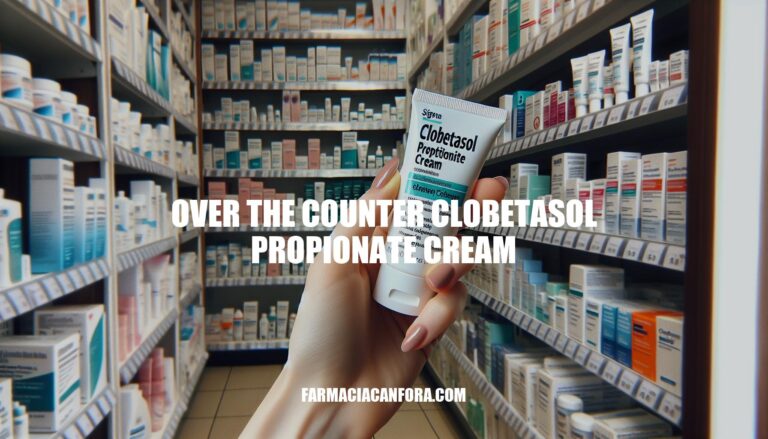Clobetasol propionate cream is a potent topical corticosteroid used to treat various skin conditions. It helps reduce inflammation, redness, and itching associated with conditions like eczema, psoriasis, and dermatitis. This cream is typically applied to affected areas to provide relief from symptoms and improve skin health.
Availability
Clobetasol propionate cream is not available over the counter. It requires a prescription from a doctor. You can purchase it at pharmacies with a valid prescription. Some online services, like Medzino, offer consultations with a physician and can deliver the medication to your door.
If you need clobetasol, it’s best to consult with your healthcare provider to get the appropriate prescription.
Uses and Benefits
Clobetasol propionate cream is a super-potent topical corticosteroid used to treat various skin conditions. Here are its specific uses and benefits:
- Eczema and Psoriasis: It reduces swelling, redness, itching, and rashes by decreasing inflammation.
- Lichen Sclerosus: Effective in treating this chronic skin condition by alleviating symptoms like itching and discomfort.
- Dermatitis and Allergies: Helps manage severe dermatitis and allergic reactions by reducing inflammation and irritation.
- Other Skin Conditions: Used for conditions like lichen planus and discoid lupus erythematosus, providing relief from inflammation and itching.
Clobetasol propionate is highly effective due to its potency, but it should be used with caution and under medical supervision to avoid potential side effects.
Application Instructions
Here’s how to properly apply clobetasol propionate cream:
- Wash your hands with soap and water before and after applying the cream.
- Apply a thin layer of the cream to the affected area.
- Rub it in gently until it is evenly distributed.
- Avoid covering the treated area with bandages or dressings unless directed by a doctor.
Dosage and Frequency:
- Use it once or twice daily as directed by your doctor.
- Do not use more than 50 grams per week.
If you have any specific conditions or concerns, it’s best to consult with a healthcare professional.
Side Effects
Potential Side Effects of Clobetasol Propionate Cream
- Burning or stinging at the application site
- Dry skin
- Redness or flushing of the skin
- Itching, scaling, or swelling
- Thinning of the skin
- Acne-like skin rash
- Increased hair growth
- Skin discoloration
What to Do If They Occur
- Burning or stinging: Stop using the cream and wash the area with mild soap and water. Consult your doctor if it persists.
- Dry skin: Use a gentle moisturizer. If it worsens, seek medical advice.
- Redness or flushing: Discontinue use and contact your healthcare provider.
- Itching, scaling, or swelling: Stop application and consult your doctor immediately.
- Thinning of the skin: Avoid further use and see a healthcare professional.
- Acne-like rash: Cleanse the area gently and avoid further use. Consult a doctor if it doesn’t improve.
- Increased hair growth: Discuss with your doctor for alternative treatments.
- Skin discoloration: Stop using the cream and seek medical advice.
Precautions
Here are important precautions to consider when using over-the-counter clobetasol propionate cream:
- Avoid using with other topical corticosteroids: Do not use clobetasol with other corticosteroid-containing products like betamethasone, hydrocortisone, or triamcinolone.
- Check for drug interactions: Clobetasol can interact with various medications, including aspirin, metoprolol, and vitamin supplements.
- Avoid certain areas: Do not apply clobetasol to your face, underarms, or groin unless directed by a doctor.
- Monitor for side effects: Regularly check for any unwanted effects, especially if used on large areas of the body or for prolonged periods.
- Avoid cosmetics on treated areas: Do not use cosmetics or other skin care products on the areas treated with clobetasol.
Always consult your healthcare provider before starting or stopping any medication.
Clobetasol Propionate Cream
Clobetasol propionate cream is a potent topical corticosteroid used to treat various skin conditions such as eczema, psoriasis, and dermatitis by reducing inflammation, redness, and itching.
It requires a prescription from a doctor and should be applied once or twice daily in a thin layer to the affected area.
Potential Side Effects
Potential side effects include burning, stinging, dry skin, and skin discoloration, which can be managed by consulting a healthcare professional.
Precautions
Precautions include avoiding use with other topical corticosteroids, checking for drug interactions, and monitoring for side effects.
It is essential to consult a doctor before starting or stopping the medication.


